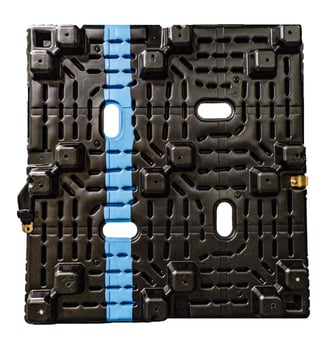10 Big Trends in Plastic Pallet Usage

The supply chain crisis occurring across the globe over the past few months has brought the normally forgotten industry of shipping to the forefront of the news. Suddenly, everyone is talking about how goods arrive and are transported.
Lost in all that discussion about cargo ships is the importance of an item that is equally important in the transfer of goods: the shipping pallet. More goods might be shipped and stored on pallets than by any other means.
At Vantage Plastics, we are on the cutting edge of pallet manufacturing, specifically plastic pallets. Our catalog contains dozens of plastic pallets we make for everything from household goods to automotive parts.
In this article, we highlight 10 insights and trends in pallet making and usage from a study done by grandviewresearch.com last year.
CRITICAL INSIGHTS ON PLASTIC PALLET USAGE
#1: The global plastic pallets market size was valued at USD 6.7 billion in 2020 and is expected to expand at a compound annual growth rate (CAGR) of 5.6% from 2021 to 2028. Growing demand for hygienic, contamination-free, and durable pallets by the food and beverage, pharmaceutical, and chemical industries is expected to drive the market.
#2: Plastic pallets are made of durable materials, such as high-density polyethylene (HDPE) and polypropylene (PP), and are designed to facilitate mechanical handling of goods by the front loader, forklift, jack, and other material handling equipment. The initial investment for plastic pallets is considerably high compared to single-use wood pallets; however, with increasing trips, a lower cost per trip can be achieved, which ensures a rapid return on investment.
#3: The U.S. market is expected to exhibit significant growth on account of increasing government focus on strengthening their manufacturing sector through trade agreements and ‘Make in America’ campaign. Besides, the companies operating in the region are increasingly opting for sustainable business practices to strengthen their brand image.
#4: Plastic pallets are expensive compared to wood pallets; thus, the risk of pallet theft or misplacing increases the overall cost of material handling. However, the introduction of active tracking devices, including RFID tags and Bluetooth, and the Internet of Things (IoT) has enabled efficient tracking of pallets and significantly reduced pallet loss. Therefore, the increased attractiveness of plastic pallets due to technological advancement is likely to fuel the market for plastic pallets in the coming years.
#5: Plastic pallets are utilized for multiple trips without being disposed of after single-use, eliminating packaging waste going into landfills and making them highly sustainable, even though they are made from non-biodegradable material. Growing government focus on reusing and recycling packaging products coupled with increasing sustainability awareness among the consumers is expected to favor market growth.
#6: The key parameter to select a pallet material, especially in the food and beverage and pharmaceutical industries, is that the material should be free from any contamination. Wood pallets have a high risk of sheltering bacteria, pests, or fungi, and the splinters or protruding nails of wooden pallets have the potential to break or tamper with the packaging. Thus, on account of the aforementioned shortcomings associated with wood pallets, plastic pallets are majorly preferred by the key end-use industries.”
#7: The hygiene of packaging and material handling products is paramount in the pharmaceutical industry. Wooden pallets pose a risk of contamination as they can harbor bacteria and fungus and are hard to clean. On the other hand, plastic pallets offer strong chemical resistance and are safe from any contamination, which makes them an ideal solution for material handling in the pharmaceutical industry.
#8: The global pharmaceutical industry has been growing at a considerable pace owing to the rising aging population, increasing incidences of chronic diseases, and the growing health consciousness, which, in turn, is expected to drive the demand for plastic pallets. Moreover, expanding production of generic pharmaceuticals is anticipated to advance the demand for plastic pallets in the pharmaceuticals’ end-use segment.
#9: Nestable pallets dominate the plastic pallets market and accounted for the largest revenue share of 43.6% in the type segment in 2020. They can be nested into each other, due to which they occupy lesser space during return freight and prove to be cost-efficient compared to other pallet types. They are also less expensive than their rackable and stackable counterparts, making them ideal for export or open-loop supply chain application.
#10: In the automobile industry, heavier pallets are preferred due to the frequent handling and transportation of heavier components from the suppliers’ facilities to automobile assembly facilities. The steady expansion of automobile and heavy metal manufacturing industries is expected to impact favorably on demand for stackable pallets over the forecast period.
CHOOSE A PLASTIC PALLET MANUFACTURER YOU CAN TRUST
At Vantage Plastics, we design and manufacture many types of thermoformed products. Protecting products in transit and in storage is extremely vital and is what we do best. Anything needed for shipping or storage can create a package for it. Pallets are what we make best.
Within our facility, we have eight single-sheet machines, five twin-sheet machines, and one sample machine dedicated to prototype samples. All of our critical services are performed in-house, from engineering to material management to production.
We have many solutions to meet your unique requirements. Contact us or call 989-846-1029 to discover how we can serve you!
WANT TO KNOW ABOUT THE ADVANTAGES OF PLASTIC PALLETS?
Check out this Vantage Plastics blog article, “7 Reasons Businesses Should Immediately Investigate Changing from the Use of Wood Pallets to Vantage Plastics’ Dynamic Plastic Pallets.”
Discover how plastic pallets are:
- Reusable
- Versatile
- Strong
- Sustainable
- Economical
- Ergonomic
